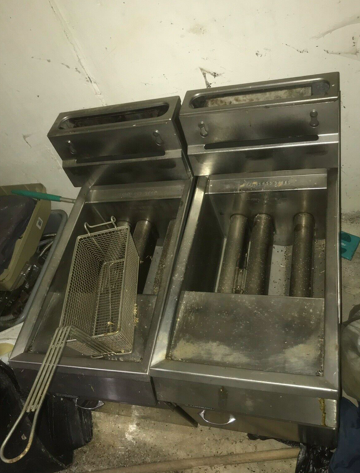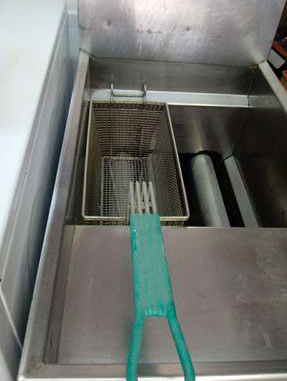Looking for a more affordable solution to add commercial deep fryers to your restaurant or food truck? Look no further than our inventory of deep fryers from top names like Pitco, Anets, and Atosa that are listed for sale directly by owners. We don’t take fees or commissions so you get the best deal possible on used restaurant equipment.
[display_listings l_type=”93″]
Introduction

Crunchy fried chicken. Crispy, sugary churros. Mountains of salty french fries. American consumers’ hunger for fried food is stronger than ever, with no signs of slowing down. The fried food boom is a boon for commercial cooks everywhere, as well; after all, it doesn’t get much simpler than battering something (anything!) and dropping it into a bubbling cauldron of hot fat, and pulling out a perfectly-cooked, golden-brown chunk of crunchy deliciousness a few minutes later.
Commercial deep fryers come in a few different shapes and sizes, but the concept is the same; deep fryers have one job to do, which is keep large volumes of vegetable, canola, or peanut oil at peak frying temperatures, ready to accept as many mozzarella sticks, donuts, or onion rings as you can fit into the basket.
Typically, the oil is heated to 375 degrees, battered or breaded food is dropped into the basket, and cooked until golden brown, before being drained on paper towels or in cardboard bowls, seasoned, and served.
What Can You Cook in a Used Commercial Deep Fryer?

While the basic function of a commercial fryer is the same across all form factors, different applications require different types of fryers. The size of the fryer, the physical orientation, and the power source are all important factors to consider.
At the most basic level, fryers can be separated into two distinct categories: Countertop or freestanding floor models. Each type of fryer has its advantages and disadvantages, relative to the planned application and type of kitchen the fryer is integrated in.
Freestanding floor fryers are an important part of any large restaurant kitchen that focuses on moving high volumes of frozen or fried food. Because these units are meant to be fired up in the morning and turned off only at closing, they can handle constant use throughout the day, while keeping energy use and oil breakdown to a minimum.
Floor fryers are generally available in both electric and propane or natural gas models, and can each sport one main cooking chamber, or multiple “pots” for frying different types of food. Most floor fryers feature deep baskets that are lifted out of the surface of the oil, with some even including programmable controls to help maintain consistency and quality.
In order to extend the usable life of the fryer oil (which is often the most expensive aspect of running a deep fryer), oil should be drained from the unit, filtered, and stored nightly. Because of their size, cleaning a freestanding floor fryer requires a fair amount of time; there’s the hot oil to deal with, as well as scraping out the sludge that tends to collect around the heating elements.
Countertop fryers offer a compromise between the raw frying power of a floor model, and a smaller physical footprint for operation. If frying isn’t a major component of your menu, or if your kitchen is short on space (such as in a food truck or concession trailer), a countertop fryer may make the most sense, since they deliver a similar quality product and require much less space. Smaller countertop fryers also typically use smaller pots for oil, making cleaning easier and extended oil life less of a consideration.
That covers the basics. Now, let’s take a look at a few of the more specialized options, for commercial deep fryers.
Most commercial kitchen appliances are required to be placed under an expensive commercial hood (which can run upwards of $1,000 per linear foot), with exaust fans, filtration, and fire suppression.
However, in many commercial applications, the installation of a hood and fire suppression system may prove difficult; your kitchen may lack the space, the roof access, or quite frankly, the capital to install a proper commercial kitchen exhaust system.
Ventless countertop fryers attempt to solve this problem in an “all in one” unit that features built-in filtration, which eliminates the need for external ventilation or fire suppression, while keeping grease and odor buildup in your kitchen to a minimum.
Because cooking donuts and funnel cakes requires more horizontal than vertical cooking area, funnel cake and donut fryers feature shallow, wide pots designed to prevent overcrowding, along with side-mounted racks to facilitate oil drainage and minimize waste. This type of specialty fryer is a staple of county fairs, carnivals, and amusement parks.
Built-in deep fryers are very similar to countertop models, only without an external steel housing for the fryer pots. Instead, drop-in fryers fit into cutouts in your existing kitchen counters, which lets them blend in seamlessly with the surrounding environment. This is particularly important for open kitchens, in food trucks, or anywhere else where the overall aesthetic of the kitchen is a factor.
Outdoor fryers are exactly that: Mobile units which allow you to bring your fried foods to your customers, without the constraints of a kitchen. These types of specialty fryers are ideal for outdoor catering, food stalls, or farmer’s markets, and are solidly built, gas-fired, and somewhat portable and mobile.
How Do You Evaluate a Used Commercial Deep Fryer?

When choosing a used commercial deep fryer for your business, there are a few different factors to consider.
The first consideration is whether you want to go with an electric or gas model. In some kitchen, this decision will be based less on the merits of the individual options, and more on which resource is readily available; if you don’t have natural gas or propane lines, an electric fryer is the obvious choice.
Gas fryers tend to heat up more quickly, can reach higher operating temperatures, and are somewhat more energy efficient for maintaining oil temperatures.
Electric fryers have heating elements which come in direct contact with the oil, which means easier cleaning, quicker recovery times between batches, and a higher ease of installation. However, these types of fryers typically take longer to heat, and are not capable of higher temperatures.
Next, consider the type of burner that’s right for your business.
Open pot fryers contain heating elements which are located outside of the oil well, which makes them easy to clean, and a good choice for pre-breaded frozen items or french fries.
Tube fryers contain pipes that run through the bottom of the oil pot, filled with gas. While they’re a good fit for high-volume or heavy-sediment cooking, they’re a pain to clean; ask any line cook that’s spent a closing shift elbow-deep in black fryer sludge.
Ribbon fryers have a ribbon-shaped heating element which runs through the fryer pot, which makes for quick heating and recovery times, but increased maintenance, difficulty cleaning, and a tendency for food to stick to the elements and burn can make using these types of fryers challenging.
Funnel cake and donut fryers are considered flat-bottom fryers, because the heating elements don’t obstruct the bottom of the tank, which makes them easy to keep clean.

Size is another consideration, when choosing a used commercial deep fryer. Consider the volume of fried food you’ll need to produce each day, and then buy the fryer that meets those needs; floor fryers range in size from a mere 11 inches, all the way up to 84 inches or more. If space allows, consider grouping multiple smaller fryers together, instead of one gigantic one; this way, you can rotate usage so that you always have a clean fryer ready to go, and will have backups in case one fryer fails.
When evaluating a used commercial deep fryer for potential purchase, it’s important to ask a few key questions. How long does a full pot of oil take to come up to 350 degrees? How well does the oil hold temperature between frying cycles, and how quickly does the temperature recover? Does the fryer feature any built-in filtration?
Check the oil pot (particularly if its removable) for leaks, and ask the seller if the fryer has ever been repaired or serviced. Heating element failure is a common problem, particularly on electric countertop fryers, so check with the manufacturer on the cost of replacement parts to get a feel for what repairs to the fryer will cost down the road. Look for signs of rust or corrosion, including around heating elements.
Finally, don’t be scared of fryers which may appear to have decades of built-up grease or oil crusted in every crack and crevice; commercial degreasers are powerful things, and we’ve seen fryers that seem destined for the scrap heap brought back to a sparkling shine. If the fryer you’re considering seems particularly dirty, try to use that as a negotiating point with the seller to secure a lower price.
